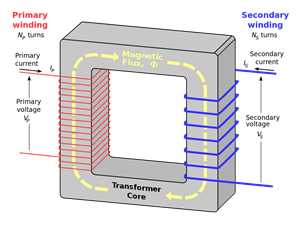
PUMPA - SMART LEARNING
எங்கள் ஆசிரியர்களுடன் 1-ஆன்-1 ஆலோசனை நேரத்தைப் பெறுங்கள். டாப்பர் ஆவதற்கு நாங்கள் பயிற்சி அளிப்போம்
Book Free DemoA transformer is an electrical device that converts low voltage to high voltage and high voltage to low voltage. It operates on the electromagnetic induction principle.
It is made up of two insulated coils:
- Primary coil
- Secondary coil
The magnetic field in the iron ring is created by the alternating current flowing through the primary coil. The iron ring's magnetic field induces a varying emf in the secondary coil.

Transformer - Circuit diagram
The voltage in the secondary coil can be stepped up or down depending on the number of turns in the primary and secondary coils.
Step-up transformer:
A step-up transformer is a transformer that converts a low alternating voltage to a high alternating voltage, Vs > Vp. The number of turns in the secondary coil in a step-up transformer is greater than the number of turns in the primary coil (Ns > Np).
Step-down transformer:
A step-down transformer is a transformer that converts a high alternating voltage to a low alternating voltage,(Vs < Vp). The number of turns in the secondary coils in a step-down transformer is less than the number of turns in the primary coil, (Ns < Np).
Important!
A step-up transformer increases voltage while decreasing current, and vice versa. In a transformer, energy is lost in the form of heat, sound, and other factors.
The transformers' formulae are given in the equations below.
Because the current in the primary coil is constant, a transformer cannot be used with a direct current (DC) source. Therefore, the number of magnetic field lines linked to the secondary coil will remain unchanged, and no emf will be induced in the secondary coil.
Reference:
https://en.wikipedia.org/wiki/File:Transformer3d_col.svg